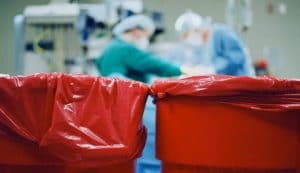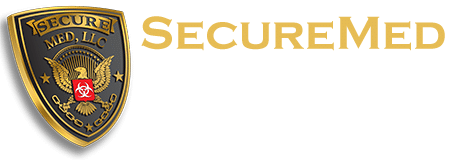
5 Types of Waste That Should NEVER Go in a Red Bag
If you work in any part of the medical industry, you know that medical waste is a big issue. The amount of medical waste produced in the US continues to increase each year – the EPA estimates that every hospital bed in the US produces anywhere between 13 and 23 pounds of waste PER DAY. If there are over a million hospital beds in the country, the numbers are staggering. Because medical waste is such a huge deal in our country, there are numerous federal and state laws to regulate the different types of waste produced, including which types of waste fall under certain categories, how it should be stored, transported, and destroyed, and what types of collection containers are required for each different kind.
Any medical office or facility has a lot to deal with on a daily basis, and you know that red trash bags are specifically designed to contain medical or biohazardous waste, but what should you put in them, and what should stay out? While there are multiple definitions for the term medical waste, OSHA defines biohazardous waste as:
- Any liquid or semi-liquid blood or other potentially infectious materials
- Contaminated items that would release blood or other potentially infectious materials in a liquid or semi-liquid state if compressed
- Items that are caked with dried blood or other potentially infectious materials and are capable of releasing these materials during handling
- Sharps (including needles, scalpel blades, glass, pipettes) contaminated with blood and body fluids
- Pathological and microbiological wastes containing blood or other potentially infectious materials
However, even though all of these types of waste are considered biohazardous, not all of them need to be disposed of in a red bag. Here’s a list of 5 types of waste that should NEVER go into a red bag:
- Sharps Waste
Red-bagged waste contains both liquid and solid biohazardous items, but sharps waste should be disposed of only in specialized sharps waste containers, which are durable, well-labeled containers that have small sealable openings to effectively isolate sharps. Any sharp item has the potential to puncture or leak in a red bag, so these items need to be taken care of properly. Sharps must be put in sharps containers at the source – they can’t be handled separately. Sharps containers must be placed in a stable stand that reduces the risk of spilling, and should be only filled up to two-thirds full at maximum before being emptied. When filled, sharps containers must be sealed closed and labeled appropriately.
- Pharmaceutical Waste
Many drug companies and local communities have drug take-back programs that are ideal places for disposal of discarded or expired medicines. The EPA’s Resource Conservation and Recovery Act (RCRA) has mandated that any drug meeting the criteria for hazardous waste should be discarded via incineration at a fully licensed and insured disposal facility. If you have pharmaceuticals that need to be disposed, put them in a plastic bag, then place them in a sturdy, sealable, clearly marked container that is leak-proof.
- Solid or Universal Waste
Also known as trash or garbage, solid waste can and should be disposed of in a regular trash can. This would include things like paper, food waste (scraps, wrappers, drink containers, etc.), product packaging, batteries, light bulbs, anything containing mercury, etc. Some of these items can be recycled or reused and may be sharp, but they should never be placed in a red bag.
- Bulk Liquids
Red bags are not designed to contain large amounts of liquids. Overfilling them will increase the risk of leakage and contamination. Small amounts of liquids in solid containers, like blood tubes and used intravenous sets, can be included in a red bag. Bulk biohazardous liquid waste must be first be processed by adding a solidifier to the liquid (some use sand), then packing it in solid containers for collection or, if applicable, can then be placed into a red bag for disposal.
- Trace Chemotherapy, X-Ray and Radioactive Waste
Waste items from these sources are not to be included in unmarked red bags. Ionizing radiation and chemotherapeutic medicines can cause burns, can release nauseating vapors and are carcinogenic (can cause cancer). Chemotherapy, x-ray and radioactive therapy-generated wastes are very dangerous and must only be contained in separate, specified containers. Waste items containing radiation must be packed inside radiation-shielded containers, while waste with traces of chemotherapy must be stored in secondary and primary sealed containers. Waste containers of chemotherapy and radioactive waste must be sealed and marked appropriately.
Trust the Professionals
Regardless of what waste your facility generates, you need to trust the proper disposal of all of your medical waste to the professionals, especially to ensure that all federal and state laws are followed and each type of waste is disposed of in the right ways. If you’re located in the greater Birmingham or Huntsville, AL areas, then SecureMed is the right partner for you! With our comprehensive list of services and a 90-day, double-your-money-back guarantee, you can ensure that all of your bases are covered without breaking your bank. Give us a call or get a quick quote today!







